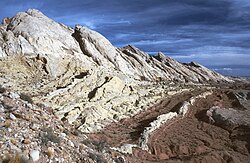| Navajo Sandstone | |
|---|---|
| Stratigraphic range: Hettangian-Sinemurian ~ | |
 A prominent cuesta of Navajo Sandstone rims the edge of the San Rafael Swell in eastern Utah | |
| Type | Geological formation |
| Unit of | Glen Canyon Group |
| Underlies | Carmel Formation and Page and Temple Cap sandstones, separated by J-1 and J-2 unconformities |
| Overlies | Kayenta Formation with conformable and interfingering contact |
| Thickness | Up to 2,300 ft (700 m) |
| Lithology | |
| Primary | Eolian sandstone |
| Other | Lacustrine limestone and dolomite |
| Location | |
| Coordinates | 36°42′N 110°48′W / 36.7°N 110.8°W |
| Approximate paleocoordinates | 23°54′N 48°30′W / 23.9°N 48.5°W |
| Region | Arizona, Colorado, Nevada, Utah |
| Country | United States of America |
| Extent | 102,300 sq mi (264,955.8 km2) - original extent of the Navajo Sand Sea may have been 2.5 times larger than this remaining outcrop |
| Type section | |
| Named for | Navajo County |
| Named by | Gregory and Stone[1] |
| Year defined | 1917 |
The Navajo Sandstone is a geological formation in the Glen Canyon Group that is spread across the U.S. states of southern Nevada, northern Arizona, northwest Colorado, and Utah as part of the Colorado Plateau province of the United States.[2]
- ^ Gregory, HE (1917), Geology of the Navajo country; a reconnaissance of parts of Arizona, New Mexico, and Utah (PDF), doi:10.3133/PP93, Wikidata Q61049764
- ^ Anonymous (2011b) Navajo Sandstone Archived 2006-09-23 at the Wayback Machine, Stratigraphy of the Parks of the Colorado Plateau Archived 2010-12-24 at the Wayback Machine. U.S. Geological Survey, Reston, Virginia. last accessed August 18, 2013

